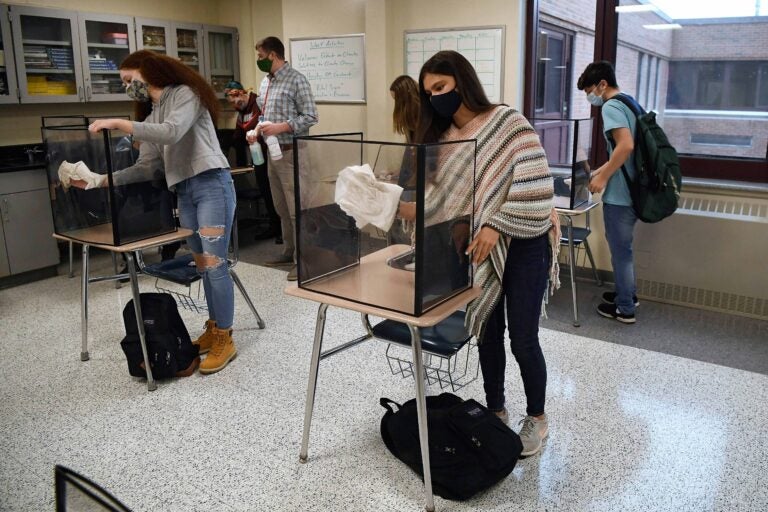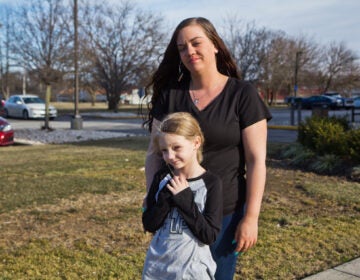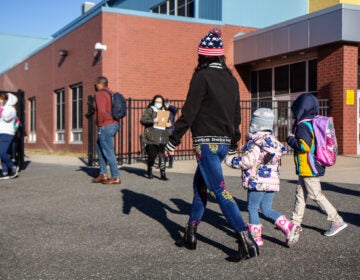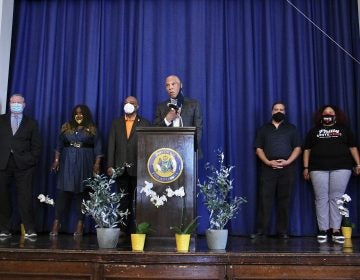CDC changes school guidance, allowing desks to be closer
The revised COVID-19 recommendations represent a turn away from the 6-foot standard that has forced some schools to remove desks and stagger scheduling.

In this March 18, 2021, file photo, students in teacher Christopher Duggan's science class clean their work areas at the end of class at Windsor Locks High School in Windsor Locks, Conn. (AP Photo/Jessica Hill)
The Centers for Disease Control and Prevention relaxed its social distancing guidelines for schools Friday, saying students can now sit 3 feet apart in classrooms.
The revised COVID-19 recommendations represent a turn away from the 6-foot standard that has forced some schools to remove desks, stagger scheduling and take other steps to keep children away from one another.
In recent months, schools in some states have been disregarding the CDC guidelines, using 3 feet as their standard. Studies of what happened in some of them helped sway the agency, said Greta Massetti, who leads the CDC’s community interventions task force.
While there is evidence of improved mental health and other benefits from in-person schooling, “we don’t really have the evidence that 6 feet is required in order to maintain low spread,” she said.
Also, younger children are less likely to get seriously ill from the coronavirus and don’t seem to spread it as much as adults do, and “that allows us that confidence that that 3 feet of physical distance is safe,” Massetti said.
The new guidance:
— Removes recommendations for plastic shields or other barriers between desks. “We don’t have a lot of evidence of their effectiveness” in preventing transmission, Massetti said.
— Advises at least 3 feet of space between desks in elementary schools, even in towns and cities where community spread is high, so long as students and teachers wear masks and take other precautions.
— Says spacing can also be 3 feet in middle and high schools, so long as there’s not a high level of spread in the community. If there is, spacing should be at least 6 feet.
The CDC said 6 feet of distance should still be maintained in common areas, such as school lobbies, and when masks can’t be worn, such as when eating.
Also, students should continue to be spaced 6 feet apart in situations where there are a lot of people talking, cheering or singing, all of which can spread droplets containing the coronavirus. That includes chorus practice, assemblies and sports events.
The CDC said teachers and other adults should stay 6 feet from one another and from students.
In Philadelphia, the change could increase the odds that all students enrolled in the city’s school district return to the classroom next fall — something Superintendent William Hite indicated was made unlikely by social distancing guidelines just a few weeks ago.
Currently, only some district students enrolled in preK through second grade have resumed in-person learning, and those students are only back in their classrooms two days a week. The district’s plan to reopen school buildings was delayed multiple times by resistance from the teachers union.
School District of Philadelphia spokesperson Monica Lewis said Friday the district will now begin reviewing occupancy numbers for building classrooms, and updating them based on the new CDC guidelines.
“We are pleased that these guidelines have come out and we do believe they will be very helpful in getting more students into in-person learning this school year,” Lewis said.
Philadelphia Federation of Teacher’s president Jerry Jordan said in a statement Friday that the union plans to review the studies that lead the CDC to change its guidance, and suggested it would resist allowing more students back in the classroom.
“In an already confusing and scary time, changes in requirements add another layer of stress and uncertainty,” Jordan said.
Some suburban school districts were already moving forward with bringing all students back for in-person instruction before Friday’s announcement.
Lower Merion School District plans to resume full in-person instruction next week, while maximizing distance in classrooms “to the extent possible,” according to spokesperson Amy Buckman.
Bristol Township’s School Board voted unanimously on Monday to scrap its hybrid plan and return to five-day-a-week classroom instruction in April. State and Federal Programs Coordinator Audrey Flojo said the board made the decision knowing the CDC was contemplating reducing its distancing guidelines.
“We are so excited the change was made,” Flojo said. “[We feel good knowing] we have the backup of the research, the science, and the support of the CDC.”
CDC Director Dr. Rochelle Walensky said the revised recommendations are an “evidence-based roadmap to help schools reopen safely, and remain open, for in-person instruction.”
“Safe in-person instruction gives our kids access to critical social and mental health services that prepare them for the future, in addition to the education they need to succeed,” she said in a statement.
Last year, the CDC advised that one way for schools to operate safely was by keeping children 6 feet apart, the same standard applied to workplaces and other settings.
In contrast, the World Health Organization suggested 1 meter — a little over 3 feet — was sufficient in schools. The American Academy of Pediatrics says to desks should be spaced 3 feet apart and “ideally” 6 feet.
The CDC guidance was problematic for many schools that traditionally had 25, 30 or more children per classroom in closely grouped desks. Some schools adopted complicated, hybrid scheduling, that might, for example, have half a class come to school on some days and the other half on other days.
The Ridley School District in suburban Philadelphia took steps like that to follow the 6-foot guideline after the CDC emphasized it last summer. But neighboring communities went with 3 feet, “and we’re not seeing the data really reflect a different spread rate,” said Lee Ann Wentzel, the district’s superintendent.
The district had already decided to shift to 3-foot distancing starting next month and invite all students to attend five days a week. But Wentzel said she was glad to hear of the change in CDC guidance because it will be easier to explain and defend the district’s decision.
A recent study in Massachusetts looked at infections of students and staff members in schools that used the 3-foot standard and those that used the 6-foot one. It found no significant difference in infection rates.
Massetti said other research has also been influential, including two studies the CDC released Friday.
One was a study in Utah that found low coronavirus transmission rates among students who did a good job wearing masks and whose desks were only 3 feet apart. The other study, done in Missouri, pointed to a similar conclusion, Massetti said.
The guidance change comes at a time when new, more contagious variants of the coronavirus are increasingly spreading. That means a continued emphasis on mask wearing and other such measures, Massetti said.

Get daily updates from WHYY News!
WHYY is your source for fact-based, in-depth journalism and information. As a nonprofit organization, we rely on financial support from readers like you. Please give today.




![CoronavirusPandemic_1024x512[1]](https://whyy.org/wp-content/uploads/2020/03/CoronavirusPandemic_1024x5121-300x150.jpg)



